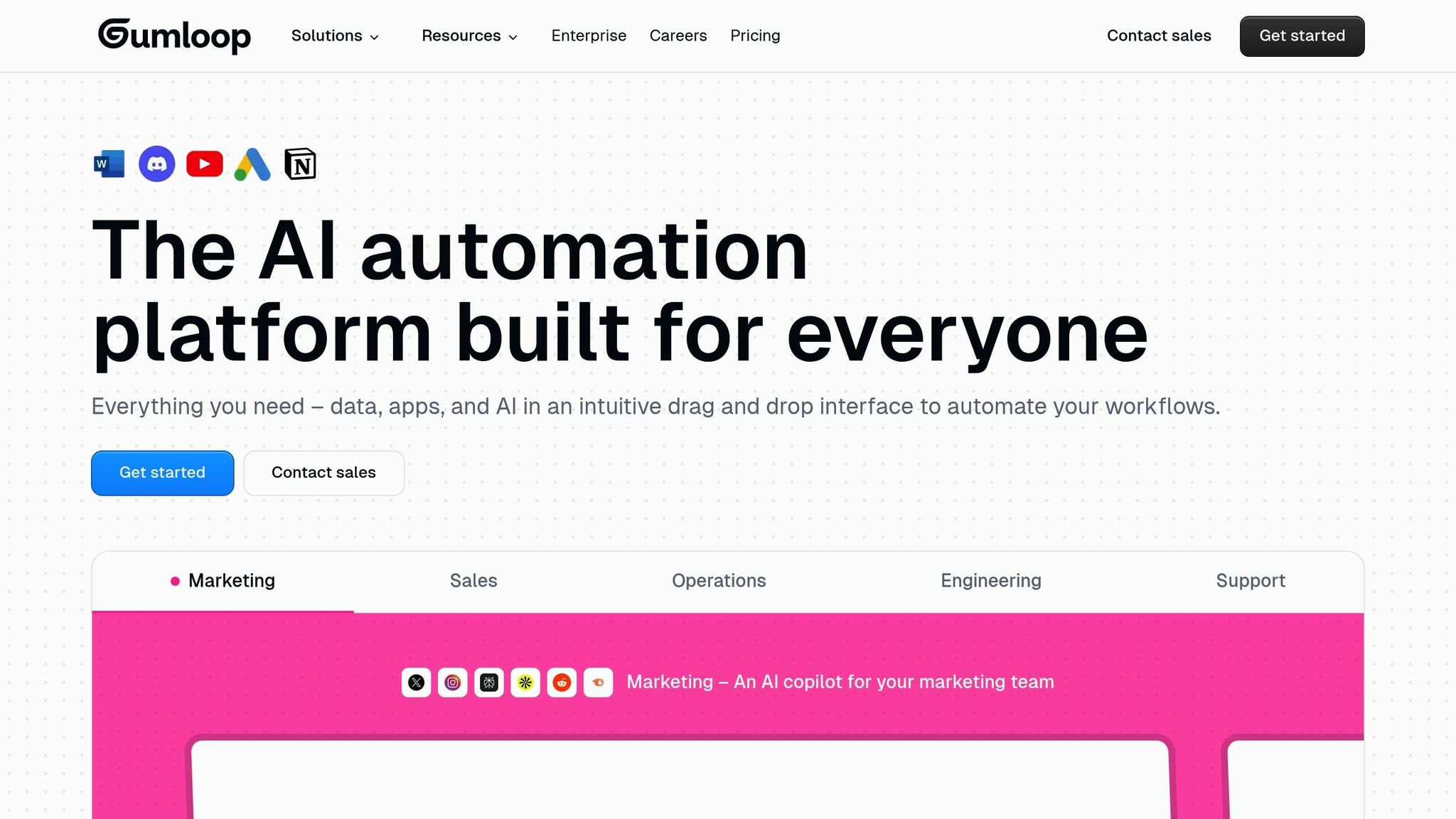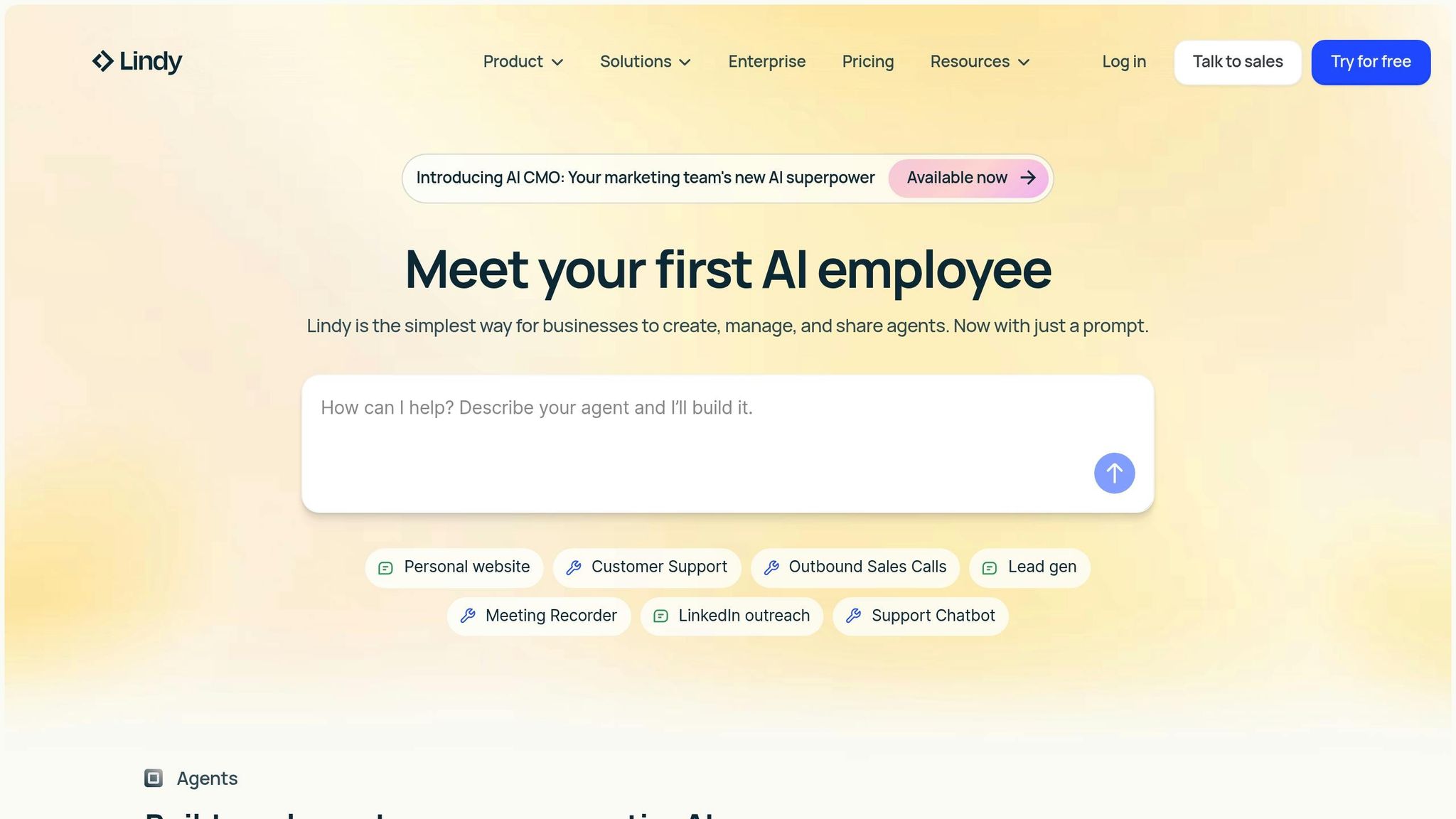
Cut AI Costs by 98% with Smarter Workflow Tools
AI workflow platforms are transforming how businesses operate, offering tools to reduce costs, improve efficiency, and simplify complex processes. With the U.S. AI market projected to reach $851.46 billion by 2034, companies are focusing on four key factors: interoperability, governance, scalability, and pricing models. This guide reviews six platforms tailored to meet these needs, helping you choose the right one for your team.
Key Takeaways:
Quick Comparison
| Platform | Strengths | Limitations | Best For |
|---|---|---|---|
| Prompts.ai | Cost savings, 35+ AI models | Growing integration ecosystem | Budget-conscious enterprises |
| Vellum AI | Developer tools, prompt engineering | Requires technical expertise | AI app developers |
| Gumloop | Scales with teams, easy to use | Limited customization | Small teams |
| Zapier | Broad app integrations | Basic AI capabilities | Simple automations |
| Lindy AI | Conversational AI workflows | Narrow focus | Customer interaction tasks |
| Workato | Security, compliance features | Higher costs, complex setup | Regulated industries |
What’s Next?
Choose a platform that aligns with your team’s expertise, budget, and goals. Whether you need enterprise security, flexible pricing, or simple automation, these tools can help you save time, cut costs, and boost productivity.

Prompts.ai is an enterprise-grade AI orchestration platform designed to address challenges like tool sprawl, governance gaps, and hidden expenses for U.S.-based businesses. Established in 2023, the company has raised $25.5 million in funding and already supports Fortune 500 companies and creative agencies.
The platform’s core mission is to streamline access to over 35 leading AI language models, including GPT-5, Claude, LLaMA, and Gemini. By consolidating these tools into one ecosystem, Prompts.ai eliminates the need for managing multiple AI platforms, simplifying both selection and integration processes.
Prompts.ai centralizes access to a wide range of AI models, addressing the inefficiencies of scattered tools. It integrates seamlessly with widely used business platforms like Slack, Gmail, and Trello, enabling smooth workflow automation within existing systems.
A practical example of its capabilities came in May 2025, when freelance AI director Johannes V. used Prompts.ai to create a promotional video by combining several AI tools. This highlighted the platform’s ability to orchestrate complex tasks across multiple models. Additionally, its side-by-side model comparison feature allows users to test various large language models in real time, significantly improving productivity for AI-driven projects.
Prompts.ai goes beyond integration by embedding strong security measures into every interaction. It adheres to key compliance standards, including SOC 2 Type II, HIPAA, and GDPR, ensuring data protection for enterprises. As part of its commitment to transparency, the platform launched its SOC 2 Type II audit process on June 19, 2025, and maintains a Trust Center where users can access real-time updates on policies and compliance controls.
Features like "Compliance Monitoring" and "Governance Administration" are included in all business plans, offering full oversight and auditability for AI interactions. These tools empower organizations of all sizes to operate with confidence, ensuring their AI processes meet enterprise-grade security requirements.
Prompts.ai is built to grow alongside its users, making it easy to scale operations. Organizations can quickly add models, users, and teams, with plans that support unlimited workspaces and collaborators.
For instance, the Problem Solver Plan offers unlimited workspaces, up to 99 collaborators, and unlimited workflow creation for $99 per month or $89 annually. Larger enterprises can choose from business plans - Core, Pro, and Elite - which provide unlimited collaborators and workspaces. Features like TOKN pooling and storage pooling further enhance scalability, making Prompts.ai an ideal solution for managing complex, large-scale operations. Its recognition by GenAI.Works as a top platform for enterprise problem-solving underscores its effectiveness in handling growing demands.
Prompts.ai’s pricing structure is designed to align costs with usage, offering transparency and flexibility. A free plan is available for users who want to explore the platform, while personal plans start at $29 per month under the Creator tier. For families, the Family Plan is priced at $99 per month.
For teams and organizations, business plans are available on a per-member basis: Core at $99, Pro at $119, and Elite at $129 per member per month. These plans include unlimited workspaces, collaborators, and interoperable workflows, with the main differences being the allocation of TOKN credits. The Pay-As-You-Go TOKN credit system ensures that costs are tied directly to AI usage, making it easier for businesses to connect their AI investments to measurable outcomes.
This pricing approach meets the needs of U.S. businesses by providing clarity and scalability in AI spending.

Vellum AI offers a platform designed to help developers build and deploy large language model applications that are ready for real-world use. With advanced tools for testing, monitoring, and deployment, it’s tailored to meet the needs of enterprises that rely on dependable AI performance at scale.
For U.S. businesses facing the challenges of integrating AI into existing systems, Vellum AI delivers a solution. Its robust APIs and development tools make it easy to connect with current enterprise infrastructure, addressing key interoperability concerns. By prioritizing production-level reliability, the platform helps organizations break through the scalability hurdles that often complicate large-scale AI adoption.
This focus on creating applications that are ready for deployment aligns with the growing demand for streamlined AI workflows. As companies look for tools that can meet enterprise-level requirements without compromising efficiency, Vellum AI stands out as a practical choice.

Gumloop stands out in the world of AI workflow platforms with its ability to grow alongside your needs. Its modular design allows small teams to start with basic automations and scale up to complex workflows as they expand. For larger organizations, Gumloop’s parallel processing and elastic cloud infrastructure ensure resources adjust seamlessly to handle increased demand. This flexibility makes it easy for businesses to enhance their automation capabilities as they evolve.

Zapier is a popular tool for automating workflows, connecting a wide range of apps with simple "if this, then that" triggers. While it’s great for basic SaaS integrations, its capabilities have both strengths and limitations. Let’s take a closer look at how Zapier handles interoperability, security, scalability, and pricing.
One of Zapier's standout features is its extensive app directory, which allows users to easily connect mainstream tools like Gmail, Slack, Salesforce, and HubSpot. Its straightforward, linear workflows make it especially appealing to non-technical users, who can set up automations without needing to write any code.
However, Zapier’s simplicity comes with limits. The platform struggles with more advanced workflows, offering only basic conditional branching and no built-in looping functionality. This means users often need to rely on workarounds for complex logic. Additionally, organizations that require integrations with on-premises systems may find Zapier's cloud-only framework restrictive.
Zapier’s security and governance features are designed for general use rather than enterprise-level requirements. Since all data passes through its cloud infrastructure, companies with strict data residency or compliance needs might encounter challenges. The platform also provides only basic security options and limited tools for testing or versioning, making it harder to manage and oversee intricate workflows.
Zapier works well for simple, event-driven tasks and is suitable for small-to-mid-sized organizations or teams looking to automate basic processes. It’s also a useful tool for prototyping and quick deployments.
However, as workflows grow in complexity, Zapier’s limitations become apparent. The lack of advanced features like robust conditional logic or looping can make it cumbersome for handling sophisticated operations. As noted in one industry analysis:
"Zapier can be cumbersome for complex logic (limited conditional branching, no loops except via hacks, etc.). In short, it's not designed for deeply complex orchestrations or on-premises integration."
For enterprises, Zapier often serves as a stepping stone. While it’s great for getting started with automation, many organizations eventually move to more advanced platforms to handle critical workflows, especially those involving AI or complex orchestration.
Zapier’s pricing starts with a free tier and plans beginning at about $20 per month. While this may seem affordable at first, costs can rise quickly as automation needs grow. Pricing is based on the number of runs and access to premium connectors, which can become expensive for high-volume operations. Many organizations find that while Zapier is budget-friendly initially, scaling up often leads to significantly higher costs.

Lindy AI stands out among AI workflow platforms by focusing on automating everyday coordination and knowledge tasks. Its natural language-based workflow creation makes automation more approachable, even for users without technical expertise.
With prebuilt AI agent templates, Lindy AI simplifies workflow setup and integrates seamlessly with popular business tools. However, it offers limited flexibility when it comes to selecting specific AI models.
While Lindy AI is effective in handling coordination and knowledge-based tasks, its enterprise features are still in the early stages of development. This makes it a better fit for small to mid-sized organizations. Its 4 out of 5 stars rating reflects these strengths and limitations, aligning with the needs of businesses seeking manageable solutions for their operations.
Lindy AI operates on a straightforward subscription model, starting at $25 per month. However, given its evolving enterprise capabilities, it’s important to carefully evaluate its features to ensure they meet your specific requirements.

Workato is a powerful automation platform designed specifically for enterprises, focusing on strict IT compliance, advanced security, and the ability to scale efficiently.
Workato prioritizes security and control with features like role-based access control (RBAC) to manage team permissions, environment separation, and lifecycle management. It also offers versioning and detailed audit logs to maintain accountability across operations. For businesses in regulated sectors, Workato provides compliance certifications to meet industry standards. To ensure secure connections, it supports on-premise agents, enabling safe access to databases and applications behind firewalls. These measures are designed to meet the demands of enterprise-scale environments without compromising security.
Built for large-scale operations, Workato’s architecture includes granular error monitoring and integrated environment management. These features make it well-suited for managing complex automation projects across multiple departments.
Each platform brings its own strengths and challenges, making it essential for businesses to weigh these factors against their specific needs. These trade-offs align with earlier discussions about interoperability, governance, and scalability - key considerations for U.S. enterprises.
Prompts.ai is a standout choice when it comes to cost efficiency and access to diverse AI models. With over 35 leading large language models available and a pay-as-you-go TOKN credit system, it eliminates recurring subscription fees, offering up to 98% cost savings. While its integration ecosystem is growing, there’s still room for expansion.
Vellum AI caters to technical teams with its focus on prompt engineering and model comparison. However, fully utilizing its advanced features often requires specialized expertise, making it better suited for users with a strong technical background.
Gumloop appeals to smaller teams or departments with its intuitive visual workflow builder, designed for non-technical users. Though easy to use, it may lack the customization options needed for more complex enterprise workflows.
Zapier is well-known for its extensive app integrations, simplifying connectivity across a wide range of tools. However, its AI functionalities are not as advanced as those offered by platforms specifically designed for AI workflow orchestration.
Lindy AI shines in automating customer interactions through conversational AI, making it an excellent choice for targeted use cases. That said, its narrow focus limits its applicability for broader workflow automation. Workato, on the other hand, provides enterprise-level security and compliance features, such as role-based access control and detailed audit logs, which are ideal for regulated industries. However, these benefits come with more complex implementations and potentially higher costs.
| Platform | Key Advantages | Main Limitations |
|---|---|---|
| Prompts.ai | Access to 35+ AI models, up to 98% cost savings, pay-as-you-go pricing | Integration ecosystem still expanding |
| Vellum AI | Developer-focused, strong on prompt engineering | Requires technical expertise |
| Gumloop | Easy-to-use visual workflow builder | Limited options for complex customizations |
| Zapier | Broad app integrations, strong community support | Less advanced AI capabilities |
| Lindy AI | Excels in conversational AI workflows | Limited to specific automation use cases |
| Workato | Enterprise-grade security and compliance features | Complex setup and higher costs |
These comparisons provide a roadmap for U.S. businesses to align platform capabilities with their operational priorities. Whether the focus is on reducing costs, simplifying workflows, leveraging technical expertise, or ensuring compliance, the right platform will depend on an organization's unique goals.
When choosing an AI workflow solution, it’s important to consider your organization’s size, expertise, and automation goals. Each platform offers distinct strengths, making it essential to match their capabilities with your operational needs.
Prompts.ai stands out by combining affordability with scalability. For businesses mindful of their budgets, Prompts.ai provides access to over 35 leading AI models while delivering up to 98% cost savings through its pay-as-you-go TOKN system - eliminating recurring fees and enabling enterprise-level orchestration.
Take a close look at your team’s technical expertise, financial constraints, and long-term objectives. Select a platform that not only complements your operational priorities but also empowers your team to achieve measurable results. By focusing on both cost efficiency and strategic alignment, businesses can unlock the full potential of AI-driven automation.
Prompts.ai is committed to safeguarding your data by following top-tier security and privacy standards, including SOC 2 Type II, HIPAA, and GDPR. These frameworks are designed to ensure your data is managed with the utmost care and protection.
To maintain this high level of trust, the platform employs continuous control monitoring through Vanta. Additionally, as of June 19, 2025, Prompts.ai has begun its SOC 2 Type II audit process, reinforcing its dedication to meeting strict regulatory demands while keeping sensitive information secure.
When selecting an AI workflow platform, it’s important to focus on features that align with your business objectives. Start by considering platforms that offer built-in AI capabilities, enabling smarter operations, and real-time data integration for seamless connectivity. Tools that require little to no coding can also make customization straightforward, empowering teams to tailor workflows without heavy technical expertise. Look for automation features like conditional logic to help streamline tasks across various systems.
Scalability should also be a priority, ensuring the platform can grow alongside your business. Equally important are strong security measures and governance tools to protect data and maintain compliance. Features like model lifecycle management and feedback loops can enhance efficiency and adaptability, helping the platform evolve with your organization’s needs. By focusing on these elements, you can find a solution tailored to your operational goals.
Prompts.ai offers a pay-as-you-go TOKN credit system tailored to help businesses manage costs effectively. Unlike traditional fixed plans that often result in overpaying for unused resources, this system lets enterprises purchase TOKN credits and allocate them across different AI models based on their needs.
This approach reduces unnecessary spending and ensures businesses only pay for what they actually use. It’s particularly beneficial for companies dealing with fluctuating or unpredictable workloads, enabling them to adjust their spending while still leveraging advanced AI tools to improve workflows and efficiency.


